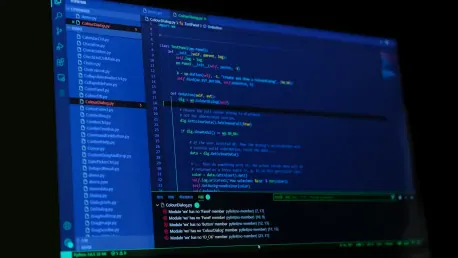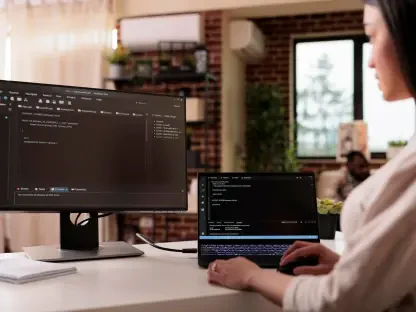The world of frontend development has seen dramatic transformations over recent years, evolving far beyond the traditional trio of HTML, CSS, and JavaScript. What began as a straightforward approach to building web interfaces has now blossomed into a complex, multi-faceted domain incorporating a wide array of advanced tools and frameworks. Historically, HTML was employed to structure content, CSS was used for styling, and JavaScript brought interactivity. However, today the developer’s toolkit is significantly more expansive, incorporating sophisticated technologies aimed at streamlining workflows and enhancing capabilities exponentially.
The Evolution of Frontend Development Tools
Modern frontend development has been revolutionized with the advent of a variety of tools designed to make workflows more efficient and robust. Among the most pivotal are bundlers such as Webpack and Rollup, which manage dependencies and asset bundling. These tools simplify the intricate task of dependency management, making the build process smoother and more reliable. Automated task runners like Gulp and Grunt have also become indispensable, handling repetitive tasks such as minification, compilation, and unit testing, thereby freeing up developers to focus on more complex problems.
Furthermore, CSS preprocessors like Sass and Less have gained immense popularity for their ability to make CSS code more modular, maintainable, and scalable. By enabling features like variables, nesting, and mixins, these preprocessors allow developers to write cleaner and more efficient stylesheets. On the testing front, tools like Puppeteer and Cypress have come to the fore, offering powerful solutions for ensuring code reliability through automated testing. Additionally, UI frameworks and libraries such as Vue.js, Angular, and React have become essential in the toolkit of modern developers, offering scalable solutions for building complex, dynamic user interfaces. While these innovations have undoubtedly boosted productivity, they have also introduced new layers of complexity that developers must navigate.
The Rise of Generative AI in Frontend Development
Generative AI technologies are currently revolutionizing frontend development by automating tasks that have traditionally required human intervention. Tools like Anima, which can convert Figma designs into React code, and Sketch2Code, which transforms wireframe sketches into HTML pages, exemplify the profound shift driven by these technologies. According to Jason, a seasoned developer, within three years, 99% of frontend development could be automated due to the advancements in these AI tools. This projection underscores the growing capability of AI in handling tasks that were once exclusively in the human domain.
Generative AI holds the promise of increased productivity by taking over mundane coding tasks, enabling developers to focus on more creative and complex issues. However, this automation introduces its own set of challenges, particularly in the realm of code quality and the necessity for skilled human oversight. Debugging AI-generated code remains a significant hurdle that developers need to address. While these tools can expedite development processes, the intricacies involved in troubleshooting and refining AI-generated code necessitate a high level of expertise and diligence.
Challenges in Modern Frontend Development
Despite the apparent benefits of automation offered by generative AI, the complexity of the frontend landscape has increased considerably. Keeping up with evolving frameworks and tools demands constant learning and adaptation from developers. Dependency management, especially with JavaScript package managers like npm and Yarn, is frequently cited as a major headache. Developers face numerous challenges in ensuring that their applications function smoothly without conflicts or instability due to dependencies. Changes in popular frameworks such as React, Redux, and Next.js further complicate the development process, causing significant frustration among developers who must frequently update their knowledge and skills.
The developer community is divided in its sentiments regarding these changes. On forums like Reddit and Quora, some developers express strong disdain for the current state of web development, citing excessive complexity and dependency issues as persistent problems. However, a notable segment of developers views these challenges as opportunities for innovation. They believe that overcoming these hurdles allows them to engage with more interesting and complex projects that push the boundaries of conventional web applications. This polarized perspective highlights the varying levels of acceptance and adaptability within the developer community, underscoring the need for a balance between innovation and stability.
Low-Code and No-Code Solutions
Another transformative trend in frontend development is the advent of low-code and no-code platforms. These solutions, such as Webflow, empower non-technical users to create and manage websites and applications without extensive developer input. By democratizing web development, these tools free up engineering teams to focus on more complex, high-value tasks. The rise of low-code and no-code platforms is reshaping how businesses approach web development, allowing for faster iterations and more immediate updates without the bottleneck of traditional development cycles.
Low-code and no-code platforms are redefining the roles of traditional frontend developers. These tools enable businesses to update and maintain their websites internally, reducing their reliance on dedicated development teams. This shift poses challenges to conventional developer roles but also opens new avenues for specialization and innovation. Developers may find themselves focusing more on optimizing and fine-tuning these platforms to suit specific needs, rather than building systems from scratch. This change necessitates a new skill set centered around understanding and leveraging these platforms to enhance business functionality and efficiency.
The Quality and Debugging of AI-Generated Code
While generative AI tools offer significant productivity benefits, they also pose substantial issues related to code quality and debugging. According to a McKinsey study, AI tools often provide coding recommendations that are incorrect, introducing errors into the codebase. This highlights the critical need for proficient developers who are adept at prompt engineering and capable of providing the contextual knowledge required to guide these AI tools effectively. The task of debugging AI-generated code remains a domain that necessitates human expertise and a deep understanding of the underlying logic and intricacies of the code.
Debugging AI-generated code is a critical task that underscores the ongoing need for skilled developers. Despite the advantages offered by automation, the nuanced understanding required for effective debugging remains a human domain. Therefore, maintaining a balance between AI-generated productivity and human oversight is crucial for ensuring code quality. Skilled developers are indispensable for identifying and rectifying errors introduced by AI, which could otherwise lead to significant problems in the application’s performance and reliability.
Community Sentiments and Developer Adaptation
The continuous evolution of frontend development tools and practices has resulted in mixed feelings within the developer community. On platforms like Reddit and Quora, some developers express strong dissatisfaction with the current state of web development, pointing to the excessive complexity and dependency issues as major concerns. However, many developers view these challenges as opportunities for growth and engagement in more interesting and complex projects. Adaptive developers who embrace the evolving landscape are better positioned to innovate and push the boundaries of conventional web applications.
As frontend development continues to evolve, the ability to adapt and stay current with new tools and frameworks will be an invaluable asset. Developers who are willing to embrace change and continuously update their skills will find themselves better equipped to handle the complexities of modern web development. The varying sentiments within the community highlight the importance of adaptability and resilience in an ever-changing field. Those who can navigate the complexities and leverage the latest tools and techniques will be better positioned to succeed in the fast-paced world of frontend development.
The Future Role of Frontend Developers
Frontend development has undergone significant evolution in recent years, moving well beyond the basic principles of HTML, CSS, and JavaScript. Initially, creating web interfaces was straightforward, relying on these three core technologies: HTML for structuring content, CSS for styling, and JavaScript for adding interactivity. However, the landscape has radically transformed, becoming far more intricate and comprehensive. Today, the developer’s arsenal includes a wide variety of advanced tools and frameworks designed to streamline workflows and enhance functionality significantly.
Frameworks like React, Vue, and Angular have redefined how we approach building user interfaces, allowing for more dynamic and maintainable code. Task runners, module bundlers, and package managers such as Webpack, Gulp, and npm have become essential for managing complex project dependencies and automating repetitive tasks. Additionally, the rise of CSS preprocessors like SASS and LESS has enabled developers to write more efficient and manageable stylesheets.
These advancements have led to an ecosystem where developers are no longer constrained by the limitations of basic HTML, CSS, and JavaScript. The integration of these sophisticated tools and technologies has not only accelerated the development process but also expanded the possibilities of what can be achieved on the web. As a result, modern frontend development is now a dynamic and ever-evolving field that pushes the boundaries of what’s possible in web design and functionality.









